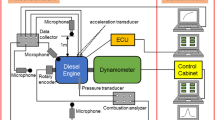Abstract
The combustion characteristics of a turbocharged diesel engine in a plateau environment have always been a focus of research on diesel engine power recovery. However, the influence of altitude on the empirical parameters of the combustion model has rarely been addressed in the literature. This paper presents a zero-dimensional combustion modeling method based on support vector machine (SVM). Taking a diesel engine as an example, the heat release rate data under different working conditions were measured on the test bench of a diesel engine at variable altitude. An SVM model was constructed and trained to predict the empirical parameters of the combustion model under varying altitude conditions, and the working process of the diesel engine was simulated. The results show that the working process simulation model with SVM prediction has better predictability. When the altitude increases, the average cylinder pressure and maximum pressure both decrease, the cylinder temperature and maximum temperature both increase, the combustion start point lags, and the combustion duration increases.
Similar content being viewed by others
Abbreviations
- C:
-
penalty parameter
- mi :
-
combustion quality coefficient
- RoHR:
-
rate of heat release
- RoHRF :
-
fitting rate of heat release
- RoHRE :
-
experimental rate of heat release
- SVM:
-
support vector machine
- β i :
-
proportion of heat release
- φ 0 :
-
start timing of combustion
- Δφ i :
-
combustion duration
- Φ(x):
-
mapping function
- ξ :
-
slack variable
- ε :
-
loss coefficient
References
Cruz, I. W. S. L., Alvarez, C. E. C., Teixeira, A. F. and Valle, R. M. (2016). Zero-dimensional mathematical model of the torch ignited engine. Applied Thermal Engineering, 103, 1237–1250.
Galindo, J., Lujan, J. M., Serrano, J. R. and Hernández, L. (2005). Combustion simulation of turbocharger HSDI diesel engines during transient operation using neural networks. Applied Thermal Engineering 25, 5–6, 877–898.
Gao, R. G., Li, G. X., Yu, Y. S. and Li, H. M. (2012). Multi-dimensional simulation for the effect of plateau environment on combustion process in diesel engine. Acta Armamentarii, 12.
Guo, M. C., Wang, X. C. and Chang, Q. (2011). Combustion characteristics of turbocharged diesel in different atmosphere environment. Diesel Engine 33, 1, 9–13.
Kan, Z. C., Lou, D. M., Cao, Z. Z., Hu, Z. Y., Liu, S. and Yang, Z. H. (2017). Effects of altitude on combustion characteristic during cold start of heavy-duty diesel engine. Int. J. Automotive Technology 18, 2, 209–217.
Li, X. R. and Ding, X. H. (2019). Survey on five tribes of machine learning and the main algorithms. Software Guide 18, 7, 4–9.
Liu, B., Hu, J., Yan, F., Turkson, R. F. and Lin, F. (2016). A novel optimal support vector machine ensemble model for NOx emissions prediction of a diesel engine. Measurement, 92, 183–192.
Maiboom, A., Tauzia, X., Hétet, J. F. and Cormerais, M. (2006). A 5-zones phenomenological combustion model for DI diesel engine for a wide range of operating conditions. Int. Conf. FISITA. Yokohama, Japan.
Penhalbel, L. T. B., Moreira, F. B. and Araújo, J. P. D. (2007). Altitude and Winter tests for best vehicle operations. SAE Technical Paper No. 2007-01-2522.
Serrano, J. R., Climent, H., Guardiola, C. and Piqueras, P. (2009). Methodology for characterisation and simulation of turbocharged diesel engines combustion during transient operation. Part 2: Phenomenological combustion simulation. Applied Thermal Engineering 29, 1, 150–158.
Szedlmayer, M. and Kweon, C. B. M. (2016). Effect of altitude conditions on combustion and performance of a multi-cylinder turbocharged direct-injection diesel engine. SAE Technical Paper No. 2016-01-0742.
Vapnik, V., Golowich, S. E. and Smola, A. (1996). Support vector method for function approximation, regression estimation and signal processing. Advances in Neural Information Processing Systems, 281–287.
Wang, X., Ge, Y., Yu, L. and Feng, X. (2013). Effects of altitude on the thermal efficiency of a heavy-duty diesel engine. Energy, 59, 543–548.
Wei, Z., Ge, Y., Lu, H. and Tan, J. (2014). A simulation on the altitude characteristics of electronically-controlled common rail diesel engine. Automotive Engineering 36, 1, 32–37.
Wong, P. K., Vong, C. and Ip, W. F. (2010). Modelling of petrol engine power using incremental least-square support vector machines for ECU calibration. Int. Conf. Optoelectronics and Image Processing. Haikou, China.
Zhao, Y. P. (2013). Review on plateau environment adaptability of diesel engine. Vehicle Engine, 4, 1–5.
Author information
Authors and Affiliations
Corresponding author
Additional information
Publisher’s Note
Springer Nature remains neutral with regard to jurisdictional claims in published maps and institutional affiliations.
Rights and permissions
About this article
Cite this article
Jing, Q., Luo, Q., Gui, Y. et al. Combustion Simulation of Variable Altitude Turbocharged Diesel Engine Using SVM. Int.J Automot. Technol. 22, 1087–1095 (2021). https://doi.org/10.1007/s12239-021-0097-0
Received:
Revised:
Accepted:
Published:
Issue Date:
DOI: https://doi.org/10.1007/s12239-021-0097-0




